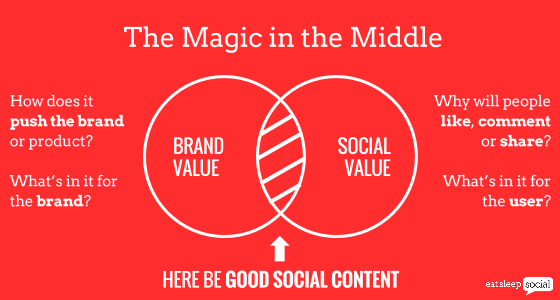
The trick to social content: it’s not magic
It’s nearly 2014. We’ve had Facebook for pretty much a decade and Twitter went public last year. Social media has become a standard part of the marketing mix. In that time there have been thousands of daily updates from brands. Some have finally managed to find their feet, or rather their voice. Sadly, countless others are languishing with mediocre content, poor engagement and almost non-existent reach.
There are some brands that are always going to struggle to produce content that people care about. Those that have no brand to speak of or those sit in low interest categories. And those brands need to question what the value of social is. Hint: it’s okay to use it as a broadcast channel if you’re not an engaging brand.
But for those lucky (or clever) brands that have a brand, a tone of voice, a point of view that people care about (or at least have a passing interest), social media offers them a powerful tool to build that brand. I’m not talking about free organic reach, we all know that’s a bust. And I’m not talking about driving ‘engagement’ amongst your fans as an objective – anyone with even a passing knowledge of how marketing works should know that it’s a poor investment. But social networks, sharing buttons, feeds, hell even email all provide a different route to customers that traditional advertising. We all know messages are more powerful if shared by friends. Social content is different from advertising because it has to give people a reason to share, to talk about it online, or if we’re desperate, to like it.
But creating cool stuff people want to share isn’t enough for brands. We are stil advertisers, not publishers. Otherwise we would just post pictures of cats. And whilst that may sound amazing, unless you’re selling pet food it doesn’t really count as marketing.
That’s not to say that every post has to have a sales message, or link through to an ecommerce site, but it does mean that your brand needs to have a reason to be posting that content. In recent years the trend towards news jacking, reactive or real time marketing has resulted in brands clambering to be the first to get a post out, regardless of whether it was a good brand fit. Royal baby? Quick, put a crown on our detergent product. Tube strike? Quick, have put funny quote in a TFL logo. Snow storm in the states? Photoshop a coat on our soft drink.
Obviously it’s not black and white, this kind of thing is not always wrong, many brands are able to demonstrate their tone of voice in how they comment, or demonstrate their brand values based on what they choose to react to. But for every good example there are hundreds of examples of pointless social posts that just try to capitalise on a trending topic, regardless of whether or not it has anything to do with the brand. And the same goes for memes, jokes and funny pictures.
Someone, somewhere decided that social was to be measured on the number of likes a post got. It was only a short period of time before some savvy community manager realised that if, instead of posting branded content, they posted images they lifted from reddit or buzzfeed then the number of likes would go up. Because people like funny stuff – they more often than not don’t like branded content. Very few people ‘like’ adverts.
Sadly it seems that most brand managers bought into this approach, which has resulted in agencies being measured on likes and comments etc, and the easiest way for them to do that is to do less and less content about the brand and more and more ‘like bait’.
The net result is that marketing was relegated to the side lines in favour of meaningless ‘engagement’. Terms like brand equity and salience were all but forgotten.
But it needn’t be this way.
The formula for good, effective social content isn’t hard. It’s finding the balance between something they care about, something that makes them smile, laugh, cry or find useful and something that promotes a product or brand. It’s the magic in the middle.

It’s this simple understanding, the balance between value to the user and value to the brand that makes the difference between advertising on the left and memes and kitten pictures on the right.
Sometimes you’ll skew to the right, sometimes you’ll skew to the left but if you want to be making good social content, you should always be striving for the middle ground. It’s really not hard. And we really shouldn’t still have to be saying it in 2014.


Leave A Comment